A mechanism by which misregulation of mitochondrial function leads to neurodegeneration was discovered by scientists.

‘The variants in the genes OGDHL and nardilysin are linked to neurodegenerative disease in humans, revealed a new study.’





"In our research we look for genes whose loss of function results in
deterioration of neurological functions in the fruit fly Drosophila
melanogaster," said first author Dr. Wan Hee Yoon, postdoctoral fellow
in the laboratory of Dr. Hugo Bellen, professor at Baylor College of
Medicine, investigator at the Howard Hughes Medical Institute, and
senior author of the paper. "In the fly we found that loss of function
of nardilysinled to a slow, progressive neurodegeneration." Yoon and colleagues discovered that nardilysin helps the folding of an important protein, an enzyme called OGDH, present in mitochondria. Loss of nardilysin function results in loss of OGDH and a build-up of a compound called a-ketoglutarate (a-KG). High levels of a-KG increase a cellular response mechanism called mTOR that normally provides clearance of cellular components such as proteins and organelles.
Yoon observed that mutation of nardilysin leads to abnormal build-up of a-KG followed by mTOR activation and eventually to slow accumulation of cellular trash. Importantly, a drug named rapamycin suppresses the neurodegenerative conditions caused by this accumulation of cellular garbage.
In 2009, a group led by Dr. Eiichiro Nishi in Japan genetically engineered a mouse to lack nardilysin.The mice developed neurological problems with motor coordination, balance and memory issues, findings which at the time were not known to be linked to the mechanism described above in the fruit fly.
The team led by Bellen realized that the results in fruit flies and in mice might suggest a role for nardilysin and its target protein OGDH in neurological problems in humans.
Advertisement
At the same time that Yoon was investigating nardilysinand its target protein OGDH, across the street co-author Dr. Ender Karaca, a postdoctoral fellow in the laboratory of Dr. James R. Lupski's group at Baylor, was working to solve a rare disease by sequencing the patient's genome through the Baylor-Hopkins Center for Mendelian Genomics (BHCMG).
Advertisement
"We realized that Ender had identified OGDHL as the top candidate gene for his patient at the same time that we were identifying OGDHL as a target of nardilysin," said Yoon. "After we saw a patient with a severe disorder and variants in OGDHL, we wondered about nardilysin," said Bellen.
The researchers then widened their search for similar patients by posting the information of the disease-causing variants of nardilysinin GeneMatcher, a web tool for rare disease researchers developed by the BHCMG team at Johns Hopkins University. Researchers looking for patients carrying rare disease genes post the gene in GeneMatcher.
If another researcher around the world has a patient with a matching gene, the teams can contact each other to share the information and collaborate. By posting nardilysinin GeneMatcher, Yoon and colleagues identified a patient whose DNA had been sequenced at the University of California in Los Angeles Clinical Genomics Center.
The patient is a 15-year-old boy who presents with symptoms that are remarkably similar to those present in the patient identified by Karaca. "We knew then that these two patients had a very similar disorder, but we had to prove that the genetic variants were causing their conditions," said Yoon and Bellen.
Using flies to study how human disease genes work
The data from the two patients were strong evidence that the variants in nardilysin and OGDHL are linked to neurodegenerative disease in humans. However, to establish that the disease variants can cause the condition, the researchers turned back to the flies where they could use genetic technology to test the variants.
"We can test a human gene side by side with a copy containing a variant from a patient in flies," said co-author Dr. Michael F. Wangler, assistant professor of molecular and human genetics at Baylor. Using this technology, Yoon showed that mutant flies carrying a normal copy of the human gene show normal development and neuronal function.
However, flies carrying genes with deleterious variants found in patients failed to rescue the loss of the genes in flies. This suggests that the mutations found in patients are indeed deleterious.
"These studies show how valuable the fruit fly model is to uncover and test genes linked to human conditions, and to work out how mutations may cause diseases," said Bellen.
Source-Eurekalert










